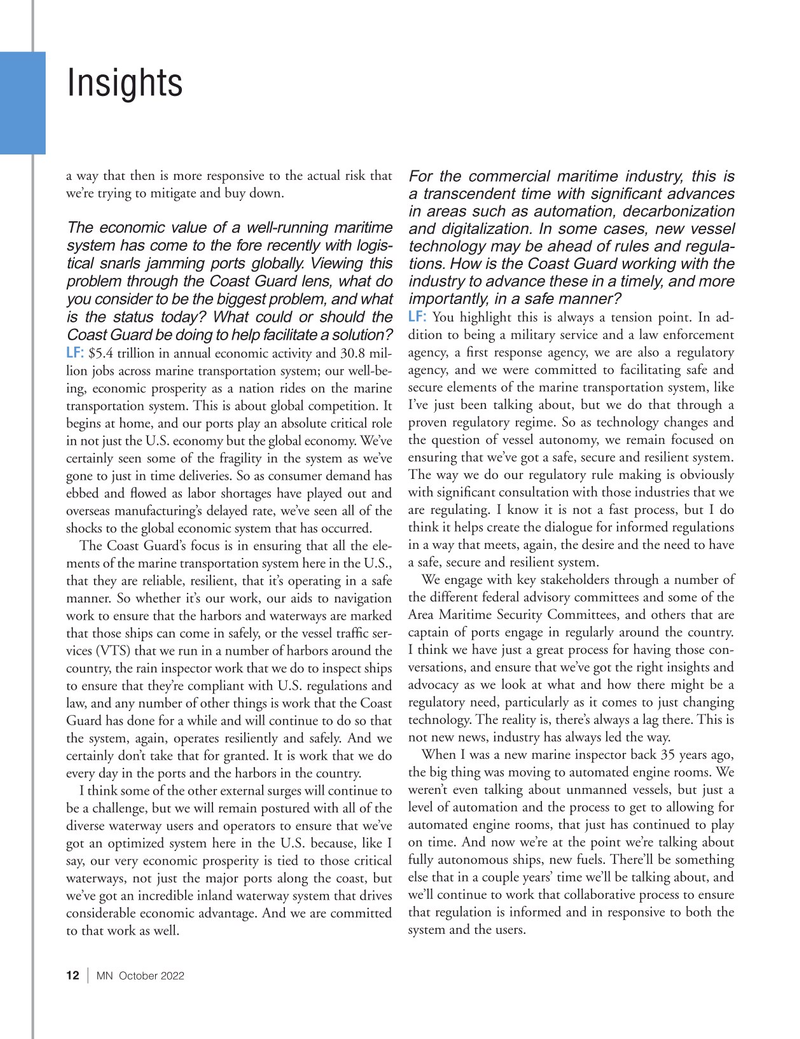
Page 12: of Marine News Magazine (October 2022)
MN100
Read this page in Pdf, Flash or Html5 edition of October 2022 Marine News Magazine
Insights a way that then is more responsive to the actual risk that
For the commercial maritime industry, this is we’re trying to mitigate and buy down.
a transcendent time with signi? cant advances in areas such as automation, decarbonization
The economic value of a well-running maritime and digitalization. In some cases, new vessel system has come to the fore recently with logis- technology may be ahead of rules and regula- tical snarls jamming ports globally. Viewing this tions. How is the Coast Guard working with the problem through the Coast Guard lens, what do industry to advance these in a timely, and more you consider to be the biggest problem, and what importantly, in a safe manner?
LF: You highlight this is always a tension point. In ad- is the status today? What could or should the dition to being a military service and a law enforcement
Coast Guard be doing to help facilitate a solution?
LF: $5.4 trillion in annual economic activity and 30.8 mil- agency, a ? rst response agency, we are also a regulatory lion jobs across marine transportation system; our well-be- agency, and we were committed to facilitating safe and ing, economic prosperity as a nation rides on the marine secure elements of the marine transportation system, like transportation system. This is about global competition. It I’ve just been talking about, but we do that through a begins at home, and our ports play an absolute critical role proven regulatory regime. So as technology changes and in not just the U.S. economy but the global economy. We’ve the question of vessel autonomy, we remain focused on certainly seen some of the fragility in the system as we’ve ensuring that we’ve got a safe, secure and resilient system. gone to just in time deliveries. So as consumer demand has The way we do our regulatory rule making is obviously ebbed and ? owed as labor shortages have played out and with signi? cant consultation with those industries that we overseas manufacturing’s delayed rate, we’ve seen all of the are regulating. I know it is not a fast process, but I do shocks to the global economic system that has occurred. think it helps create the dialogue for informed regulations
The Coast Guard’s focus is in ensuring that all the ele- in a way that meets, again, the desire and the need to have ments of the marine transportation system here in the U.S., a safe, secure and resilient system.
that they are reliable, resilient, that it’s operating in a safe We engage with key stakeholders through a number of manner. So whether it’s our work, our aids to navigation the different federal advisory committees and some of the work to ensure that the harbors and waterways are marked Area Maritime Security Committees, and others that are that those ships can come in safely, or the vessel traf? c ser- captain of ports engage in regularly around the country. vices (VTS) that we run in a number of harbors around the I think we have just a great process for having those con- country, the rain inspector work that we do to inspect ships versations, and ensure that we’ve got the right insights and to ensure that they’re compliant with U.S. regulations and advocacy as we look at what and how there might be a law, and any number of other things is work that the Coast regulatory need, particularly as it comes to just changing
Guard has done for a while and will continue to do so that technology. The reality is, there’s always a lag there. This is the system, again, operates resiliently and safely. And we not new news, industry has always led the way.
certainly don’t take that for granted. It is work that we do When I was a new marine inspector back 35 years ago, every day in the ports and the harbors in the country. the big thing was moving to automated engine rooms. We
I think some of the other external surges will continue to weren’t even talking about unmanned vessels, but just a be a challenge, but we will remain postured with all of the level of automation and the process to get to allowing for diverse waterway users and operators to ensure that we’ve automated engine rooms, that just has continued to play got an optimized system here in the U.S. because, like I on time. And now we’re at the point we’re talking about say, our very economic prosperity is tied to those critical fully autonomous ships, new fuels. There’ll be something waterways, not just the major ports along the coast, but else that in a couple years’ time we’ll be talking about, and we’ve got an incredible inland waterway system that drives we’ll continue to work that collaborative process to ensure considerable economic advantage. And we are committed that regulation is informed and in responsive to both the to that work as well. system and the users.
12 | MN October 2022

 11
11

 13
13
